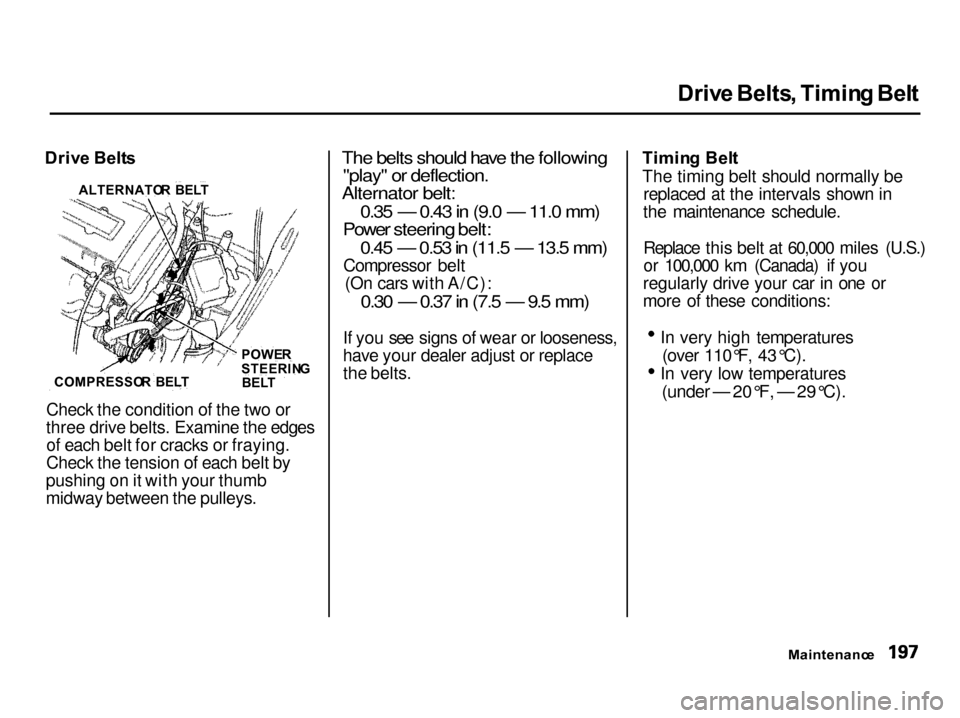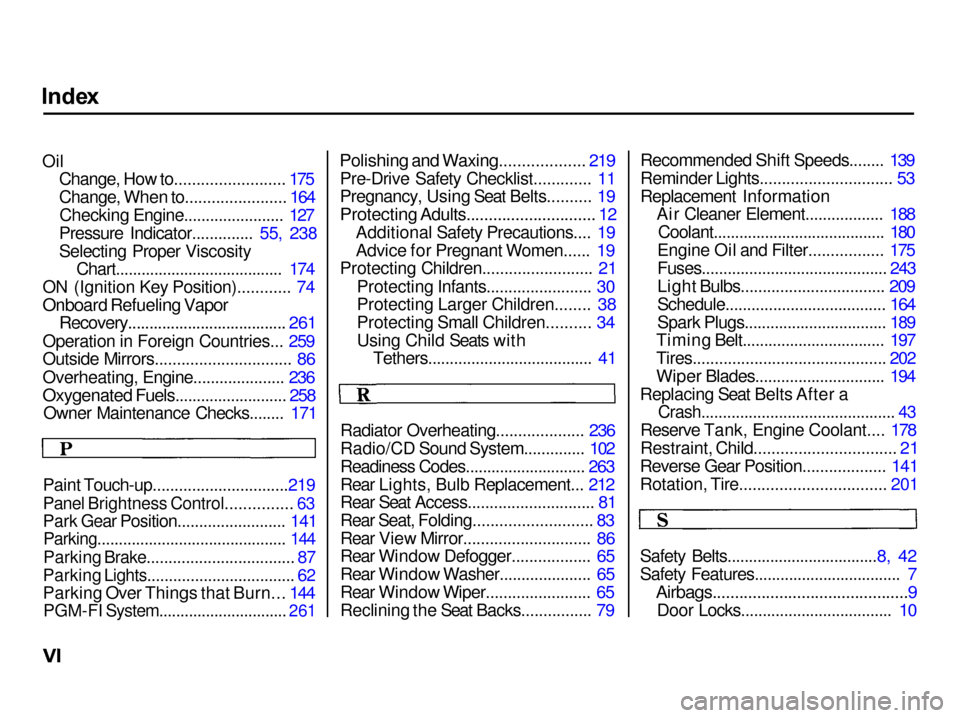maintenance schedule Acura Integra 2001 Owner's Guide
[x] Cancel search | Manufacturer: ACURA, Model Year: 2001, Model line: Integra, Model: Acura Integra 2001Pages: 285, PDF Size: 3.79 MB
Page 200 of 285

Driv
e Belts , Timin g Bel t
Driv e Belt s
Check the condition of the two or
three drive belts. Examine the edges of each belt for cracks or fraying.
Check the tension of each belt by
pushing on it with your thumb
midway between the pulleys.
The belts should have the following
"play" or deflection.
Alternator belt:
0.35 — 0.43 in (9.0 — 11.0 mm)
Power steering belt:
0.45 — 0.53 in (11.5 — 13.5 mm)
Compressor belt (On cars with A/C):
0.30 — 0.37 in (7.5 — 9.5 mm)
If you see signs of wear or looseness,
have your dealer adjust or replace
the belts. Timin
g Bel t
The timing belt should normally be replaced at the intervals shown in
the maintenance schedule.
Replace this belt at 60,000 miles (U.S.)
or 100,000 km (Canada) if you
regularly drive your car in one or
more of these conditions: In very high temperatures
(over 110°F, 43°C). In very low temperatures
(under — 20°F, — 29°C).
Maintenance
COMPRESSO
R BEL T POWE
R
STEERIN G
BEL T
ALTERNATO
R BEL T
Page 219 of 285

Storin
g You r Ca r
If you need to park your car for an
extended period (more than one
month), there are several things you should do to prepare it for storage.
Proper preparation helps prevent
deterioration and makes it easier to
get your car back on the road. If
possible, store your car indoors. Fill the fuel tank.
Change the engine oil and filter
(see page 175). Wash and dry the exterior
completely.
Clean the interior. Make sure the
carpeting, floor mats, etc. are
completely dry.
Leave the parking brake off. Put
the transmission in Reverse
(5-speed manual) or Park
(automatic).
Block the rear wheels.
If the car is to be stored for a
longer period, it should be
supported on jackstands so the
tires are off the ground. Leave one window open slightly (if
the car is being stored indoors). Disconnect the battery.
Support the front and rear wiper
blade arms with a folded towel or
rag so they do not touch the
windshield.
To minimize sticking, apply a
silicone spray lubricant to all door
and hatch seals. Also, apply a body
wax to the painted surfaces that mate with the door and hatch seals. Cover the car with a "breathable"
cover, one made from a porous
material such as cotton. Nonporous materials, such as
plastic sheeting, trap moisture,
which can damage the paint. If possible, run the engine for a
while periodically (preferably once a month).
If you store your car for 12 months or longer, have your Acura dealer
perform the inspections called for in
the 24 months/30,000 miles (48,000
km) maintenance schedule (Normal Conditions) as soon as you take it
out of storage (see page 164). The
replacements called for in the
maintenance schedule are not
needed unless the car has actually
reached that time or mileage.
Maintenanc e
Page 263 of 285

Emission
s Control s
The burning of gasoline in your car's engine produces several byproducts.
Some of these are carbon monoxide (CO), oxides of nitrogen (NOx) and
hydrocarbons (HC). Gasoline evaporating from the tank also
produces hydrocarbons. Controlling
the production of NOx, CO, and HC
is important to the environment. Under certain conditions of sunlight
and climate, NOx and HC react to
form photochemical "smog." Carbon monoxide does not contribute to
smog creation, but it is a poisonous
gas.
Th
e Clea n Ai r Ac t
The United States Clean Air Act* sets standards for automobile
emissions. It also requires that
automobile manufacturers explain to
owners how their emissions controls
work and what to do to maintain them. This section summarizes how
the emissions controls work.Scheduled maintenance is on page
164.
* In Canada, Acura vehicles comply
with the Canadian Motor Vehicle Safety Standards (CMVSS) for
Emissions valid at the time they are
manufactured. Crankcas
e Emission s Contro l
Syste m
Your car has a Positive Crankcase
Ventilation System. This keeps gasses that build up in the engine'scrankcase from going into the
atmosphere. The Positive Crankcase
Ventilation valve routes them from the crankcase back to the intake
manifold. They are then drawn into
the engine and burned.
Evaporativ e Emission s Contro l
Syste m
As gasoline evaporates in the fuel tank, an evaporative emissionscontrol canister filled with charcoal
adsorbs the vapor. It is stored in this
canister while the engine is off. After
the engine is started and warmed up,
the vapor is drawn into the engine and burned during driving.
Technica l Informatio n
Page 280 of 285

Inde
x
Jacking up the Car......................... 228
Jack, Tire........................................ 228
Jump Starting................................. 233
Keys................................................... 71
Label, Certification........................ 252Lane Change, Signaling.................. 63
Lap/Shoulder Belts.................. 16, 42
Leather, Cleaning.........................
. 221
Lighter, Cigarette............................ 90
Lights Bulb Replacement..................... 209
Indicator........................................ 53
Parking.......................................... 62
Turn Signal................................... 63
Limited Slip Differential............... 148
Load Limit...................................... 133 LOCK (Ignition Key Position)....... 74
Locks
Anti-theft Steering Column........ 74
Fuel Fill Door............................. 124Glove Box..................................... 78
Hatch............................................. 76
Power Door and Hatch............... 75
Low Coolant Level......................... 128
Lower Gear, Downshifting to a.... 138 Low Fuel Indicator.......................... 54
Low Oil Pressure Indicator... 55,
238
Lubricant Specification
s
Chart................................... 254, 255
Luggage.......................................... 132 Maintenance................................... 159
Owner Maintenance Checks.... 171
Record.................................. 169-170
Required Indicator....................... 60
Schedule.............................. 164-168
Malfunction Indicator Lamp. 55, 240
Manual Transmission.................... 138
Manual Transmission Fluid......... 185
Meters, Gauges................................ 58
Methanol in Gasoline.................... 258
Mirrors, Adjusting........................... 86
Moonroof.......................................... 85
Closing Manually....................... 242
Operation...................................... 85
Neutral Gear Position.................... 141 New Vehicle Break-in................... 123
Normal Shift Speeds...................... 139
NOTICE, Explanation of.................... i
Numbers, Identification................ 252
Octane Requirement, Gasoline.... 123
Odometer.......................................... 58
Odometer, Trip................................ 58
CONTINUED
Page 281 of 285

Inde
x
Oil Change, How to......................... 175
Change, When to....................... 164
Checking Engine....................... 127
Pressure Indicator.............. 55, 238
Selecting Proper Viscosity Chart....................................... 174
ON (Ignition Key Position)............ 74
Onboard Refueling Vapor
Recovery..................................... 261
Operation in Foreign Countries... 259
Outside Mirrors............................... 86
Overheating, Engine..................... 236
Oxygenated Fuels.......................... 258
Owner Maintenance Checks........ 171
Paint Touch-up...............................219
Panel Brightness Control............... 63
Park Gear Position......................... 141
Parking............................................ 144
Parking Brake.................................. 87
Parking Lights.................................. 62
Parking Over Things that Burn... 144
PGM-FI System..............................
261
Polishing an
d Waxing................... 219
Pre-Drive Safety Checklist.............
11
Pregnancy, Usin
g Seat Belts.......... 19
Protecting Adults............................. 12
Additional Safety Precautions.... 19
Advice for Pregnant Women...... 19
Protecting Children......................... 21
Protecting Infants........................ 30
Protecting Larger Children........
38
Protecting Smal
l Children.......... 34
Using Child Seats with Tethers...................................... 41
Radiator Overheating.................... 236
Radio/CD Sound System.............. 102
Readiness Codes............................ 263
Rear Lights, Bulb Replacement... 212
Rear Seat Access............................. 81
Rear Seat, Folding........................... 83
Rear View Mirror............................. 86
Rear Window Defogger.................. 65
Rear Window Washer..................... 65
Rear Window Wiper........................ 65
Reclining the Seat Backs................ 79 Recommended Shift Speeds........ 139
Reminder Lights.............................. 53
Replacement Information
Air Cleaner Element.................. 188
Coolant........................................ 180
Engine Oil and Filter................. 175
Fuses........................................... 243
Light Bulbs................................. 209
Schedule..................................... 164
Spark Plugs................................. 189
Timing Belt................................. 197
Tires............................................ 202
Wiper Blades.............................. 194
Replacing Seat Belts After a
Crash............................................. 43
Reserve Tank, Engine Coolant.... 178
Restraint, Child................................ 21
Reverse Gear Position................... 141
Rotation, Tire................................. 201
Safety Belts...................................8, 42
Safety Features.................................. 7
Airbags............................................9
Door Locks................................... 10